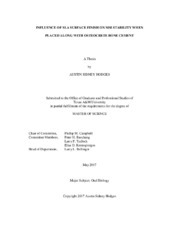| dc.description.abstract | The purpose of this study will be to compare the stability of 7 mm sandblasted, acid-etched (SLA) titanium miniscrew implants (MSIs), to 7 mm machine polished titanium MSIs.
Using a randomized, split mouth design in six skeletally mature male beagle dogs, 28 machine polished MSIs placed with OsteoCrete were compared to 28 SLA MSIs placed with OsteoCrete. Both groups of MSIs were placed along with a magnesium bone cement (OsteoCrete). Osstell ISQ measurements of MSI stability were taken weekly for nine weeks. Bone volume fractions and bone mineral densities of the layer of bone 10-20 μm from the MSIs were evaluated using micro-computed tomography (μCT). Histology was used to evaluate new bone formation and the bone cement-to-MSI interface.
The control and experimental MSIs had a success rate of 93.1% and 100%, respectively. The groups had nearly identical ISQ values at the time of placement. The decrease in ISQ values during the first 2 weeks was significantly (p=0.024) greater in the experimental than control MSIs. Difference in ISQ values continued to increase between week 2 and 8, with statistically significant (P<0.05) differences at weeks 5, 6, 7, and 8. The differences in bone volume fraction (BV/TV) and bone mineral density (gHA/cm^3) were not statistically significant between the two groups. Immunofluorescence showed no new bone within the OsteoCrete, nor along the MSI surface when OsteoCrete was present. There was new bone around and up to the edge of the OsteoCrete. Osteoblasts were evident in trabecular bone, but not adjacent to regions filled with OsteoCrete. The H&E sections showed areas of acellular bone extending approximately 0.25 - 0.5 mm from the MSI. There were minimal Howship’s lacunae and osteoclasts noted, as well as minimal inflammatory cells present.
SLA MSIs placed along with OsteoCrete had decreased primary and secondary stability. OsteoCrete is biocompatible but it is slowly resorbed and inhibits the normal healing process that is expected to occur around MSIs. | en |


